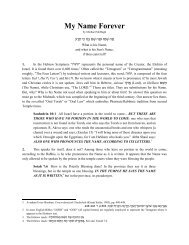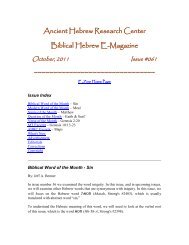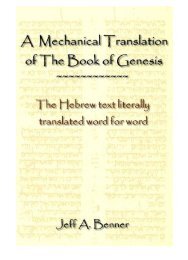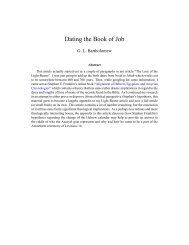Ancient Hebrew Language and Alphabet
Ancient Hebrew Language and Alphabet
Ancient Hebrew Language and Alphabet
You also want an ePaper? Increase the reach of your titles
YUMPU automatically turns print PDFs into web optimized ePapers that Google loves.
<strong>Ancient</strong> <strong>Hebrew</strong> <strong>Language</strong> <strong>and</strong> <strong>Alphabet</strong><br />
be found in Psalms 103:8; “The LORD is compassionate<br />
<strong>and</strong> gracious, Slow to anger, abounding in love”. The<br />
words compassion, grace, anger <strong>and</strong> love are all abstract<br />
words, ideas that cannot be experienced by the senses.<br />
Why do we find these abstract words in a passage of<br />
concrete thinking <strong>Hebrew</strong>s? Actually, these are abstract<br />
English words used to translate the original <strong>Hebrew</strong><br />
concrete words. The translators often translate this way<br />
because the original <strong>Hebrew</strong> makes no sense when<br />
literally translated into English.<br />
Let us take one of the above abstract words to<br />
demonstrate the translation from a concrete <strong>Hebrew</strong> word<br />
to an abstract English word. Anger, an abstract word, is<br />
actually the <strong>Hebrew</strong> word @a / awph which literally<br />
means “nose”, a concrete word. When one is very angry,<br />
he begins to breath hard <strong>and</strong> the nostrils begin to flare. A<br />
<strong>Hebrew</strong> sees anger as “the flaring of the nose (nostrils)”.<br />
If the translator literally translated the above passage<br />
“slow to nose”, the English reader would not underst<strong>and</strong>.<br />
Appearance vs. Functional Description<br />
Greek thought describes objects in relation to its<br />
appearance. <strong>Hebrew</strong> thought describes objects in relation<br />
to its function.<br />
A Greek description of a common pencil would be; "it is<br />
yellow <strong>and</strong> about eight inches long". A <strong>Hebrew</strong><br />
description of the pencil would be related to its function<br />
such as "I write words with it". Notice that the <strong>Hebrew</strong><br />
description uses the verb "write" while the Greek<br />
description uses the adjectives "yellow" <strong>and</strong> "long".<br />
23






